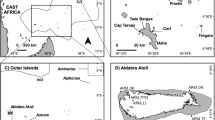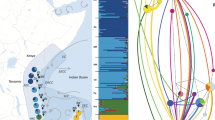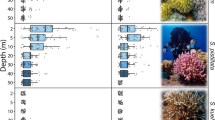Abstract
As most coral reef organisms with a pelagic larval phase are presumed to be readily dispersed between distant populations, sea-surface current patterns should be crucial for predicting ecological and genetic connections among threatened reef populations1. Here we investigate this idea by examining variations in the genetic structuring of populations of the mantis shrimp Haptosquilla pulchella taken from 11 reef systems in Indonesia, in which a series of 36 protected areas2 are presumed to be connected by strong ocean currents. Our results reveal instead that there is a strong regional genetic differentiation that mirrors the separation of ocean basins during the Pleistocene low-sea-level stands, indicating that ecological connections are rare across distances as short as 300–400 km and that biogeographic history also influences contemporary connectivity between reef ecosystems.
This is a preview of subscription content, access via your institution
Access options
Subscribe to this journal
Receive 51 print issues and online access
$199.00 per year
only $3.90 per issue
Buy this article
- Purchase on Springer Link
- Instant access to full article PDF
Prices may be subject to local taxes which are calculated during checkout

Similar content being viewed by others
References
Roberts, C. M. Science 278, 1454–1457 ( 1997).
Llewellyn, G., Jepson, P., Schweithelm, J. & Kirtchener, D. Conservation Assessment of Wallacea Bioregion (Wallacea Program Report, 1999).
Wyrtki, K. NAGA Report,Volume 2: Physical Oceanography of the South East Asian Waters (Scripps Institute of Oceanography, San Diego, 1961 ).
Lukas, R. et al. J. Geophys. Res. 96, 7089– 7104 (1991).
Swearer, S. E., Caselle, J. E., Lea, D. W. & Warner, R. R. Nature 402, 799–802 ( 1999).
Jones, G. P., Milicich, M. J., Emslie, M. J. & Lunow, C. Nature 402, 802–804 ( 1999).
Knowlton, N. & Keller, B. D. Bull. Mar. Sci. 39 , 213–223 (1986).
Excoffier, L., Smouse, P. E. & Quattro, J. M. Genetics 4, 479– 491 (1992).
Porter, S. C. Quat. Res. 32, 245–261 ( 1989).
McManus, J. W. Proc. 5th Int. Coral Reef Symp. 4, 133– 138 (1985).
Randall, J. E. Zool. Stud. 37, 227–268 (1998).
Palumbi, S. R. Coral Reefs 16 (suppl.), 47– 52 (1997).
Palumbi, S. R. in Marine Community Ecology (eds Berness, M., Gaines, S. & Hay, M.) (Sinauer, Sunderland, MA, in the press).
Barber, P. H. & Erdmann, M. V. J. Crust. Biol. 20 , 20–36 (2000).
Author information
Authors and Affiliations
Corresponding author
Rights and permissions
About this article
Cite this article
Barber, P., Palumbi, S., Erdmann, M. et al. A marine Wallace's line?. Nature 406, 692–693 (2000). https://doi.org/10.1038/35021135
Published:
Issue Date:
DOI: https://doi.org/10.1038/35021135
This article is cited by
-
Cryptic diversification, phenotypic plasticity, and host specialization in a sponge-dwelling goby
Coral Reefs (2024)
-
The Coral Triangle and Strait of Malacca are two distinct hotspots of mangrove biodiversity
Scientific Reports (2023)
-
Disentangling population structure in marine species
Nature Reviews Genetics (2023)
-
Unweaving a hard taxonomic knot in coral reef dwellers: integrative systematics reveals two parallel cryptic species complexes in ‘marbled’ shrimps of the genus Saron Thallwitz 1891 (Caridea: Hippolytidae)
Coral Reefs (2023)
-
Molecular evidence for extensive discontinuity between peracarid (Crustacea) fauna of Macaronesian islands and nearby continental coasts: over fifty candidate endemic species
Marine Biology (2022)
Comments
By submitting a comment you agree to abide by our Terms and Community Guidelines. If you find something abusive or that does not comply with our terms or guidelines please flag it as inappropriate.



